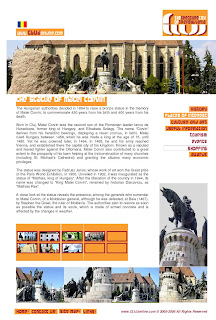
Birthplace of Mathias Korvin in
Cluj (Kolozsvár)--Romania

Mathias Korvin in Cluj(Kolozsvár)
made by sculptor János Fadrusz
Slovenia-Romania
Celje-Brasov
The students of Poslovno-komercialna šola Celje participate in the project for Eastern Europe ACES. ACES – The Academy of central European schools from Vienna invited in cooperation with the Ministy of education the schools from Slovenia to take part in the project; the invitation was accepted by 12 Slovenian schools. The ACES project includes secondary schools from Austria, Croatia, Czech Republic, Hungary, Serbia, Slovakia and Slovenia.
Our partner school is the school from Brasov in Romania Colegiul National »Aprily Lajos«. With our partner school we are looking for common points in history and culture of both cities and nations. We are going to search for historical events which are relevant for both cities and nations.
At studying history, we have found out that the Transilvanian noble army, being part of the Christian army, fought against the Turks in the battle at Nikopolje in 1396. The Slovenes and the Romanians had a common enemy. We have also discovered that our Kralj Matjaž - King Mathias comes from Transilvania and that both nations know folk songs about Mathias Korvin.
These are the findings that unite us, but we hope that we will find some more.
In Savinja region, which was a part of Carniola from 1100 until 1311, von Sannegg were already mentioned in 1173, between years 1341 and 1436 Counts of Cilli, and in years 1436 and 56 Princes of state (with establishment of principality of Celje, they were exalted by emperor Sigismund of Luxemburg). They were reigning family with important European connections. They were controlling a big part of Slovenian region and had their headquarters in Celje. After the year of 1436 they became the most significant rivals of Counts of Habsburg. Since the 12th century they were spreading their estates and connections, especially by weddings (for example with the daughters of Bosnian Ban and Polish King), but at the same time they were sustaining their own culture and founding towns and cloisters. Interfering in European governmental affairs was fatal for them. In 14th century their sudden ascent began (annexation of Savinja region to
In 1322 they gained some

V Savinjski krajini, ki je bila leta 1100 – 1311 del Krajnske, so že leta 1173 omenjeni Žovneški, od leta 1341 – 1436 Celjski grofje in v letih 1436 – 56 državni knezi (z ustanovitvijo Celjske kneževine jih je povzdignil cesar Sigismund Luksemburški). Celjani so bili vladarska družina s pomembnimi evropskimi zvezami. Obvladovali so znaten del slovenskega ozemlja in imeli svoj sedež v Celju, po letu 1436 so bili tudi najresnejši tekmec Habsburžanov. Od 12. stol. so zlasti s porokami (napr. s hčerama bosanskega bana in poljskega kralja) in vojaškimi službami širili svojo posest in zveze, hkrati pa so podpirali tudi kulturo ter ustanavljali mesta in samostane. Vpletanje v evropske vladarske zadeve je bilo za njih tudi usodno. Njihov skokovit vzpon se je začel v 14. stol. (pri tem je pomembna priključitev Savinjske krajine k Štajerski 1311). Leta 1322 so si pridobili posesti Vovberžanov s sedežem v Celju, kupovali so posesti na Kranjskem in leta 1341 postali grofje. Vojaško so služili več vladarjem, vrhunec so dosegli pod Hermanom II. Celjskim (1392 - 1435). Ta je v bitki s Turki pri Nikopolju leta 1396 cesarju Sigismundu Luksemburškemu rešil življenje. Postal slavonski in dalmatinski ban in silno je povečal posesti, sinovoma je zagotovil knežji naslov, s čimer so se Celjski izenačili s Habsburžani. Z njimi so se zapletli v posestne in strateške boje, ki so se končali z medsebojno dedno pogodbo za notranjeavstrijske posesti. Ko je Urlik II. poskušal še dejavneje poseči v evropsko dinastično politiko (oklical se je za kraljevega namestnika na Ogrskem), so proti njemu skovali zaroto, ki se je končala z njegovim ubojem leta 1456 v Beogradu. Tako so posesti in oblast Celjskih prišle v roke Habsburžanov, Ogrsko pa prevzame Matija Korvin, Z današnjega slovenskega ozemlja je izginilo zadnje pomembno središče oblasti.